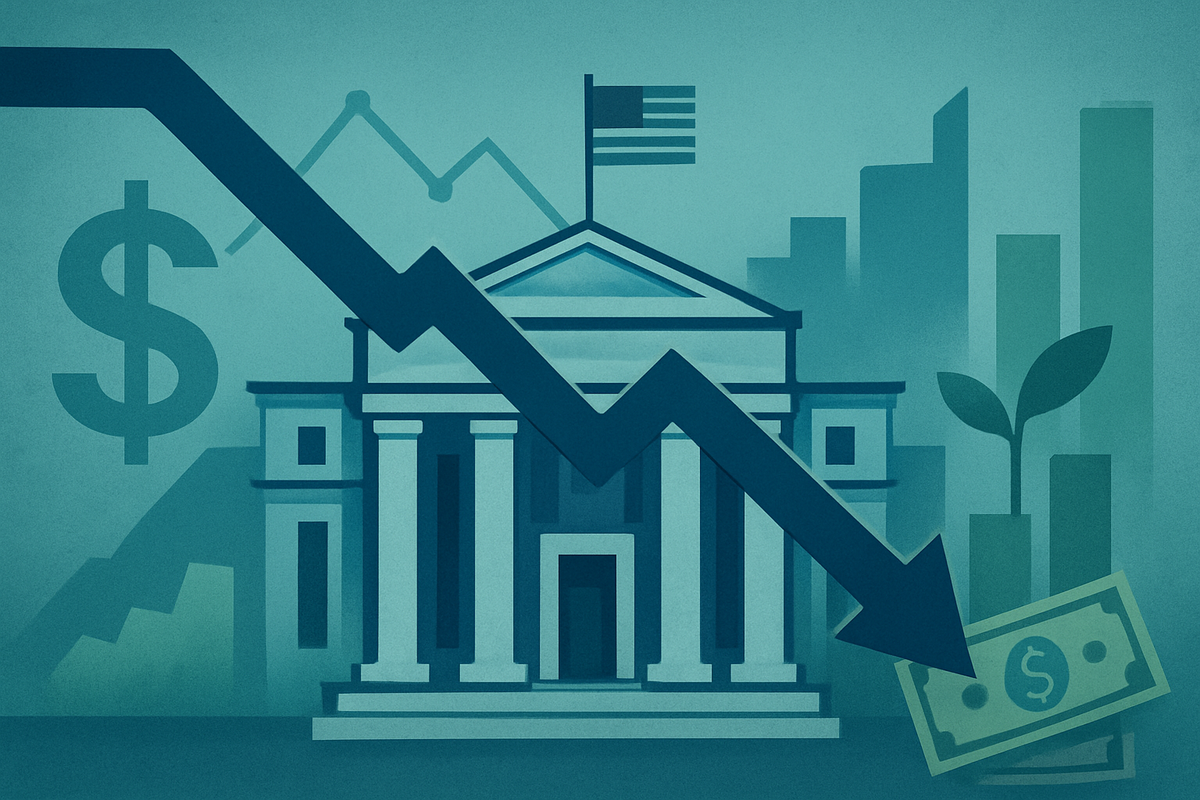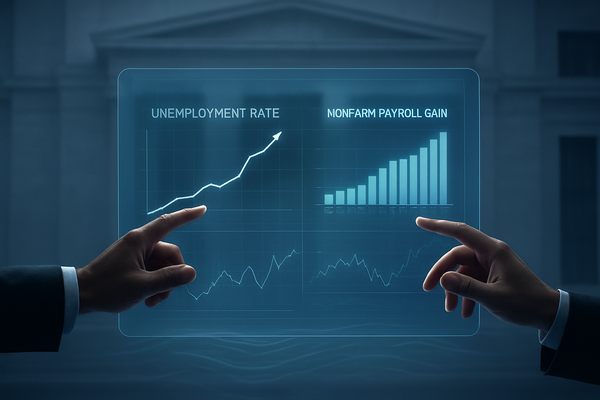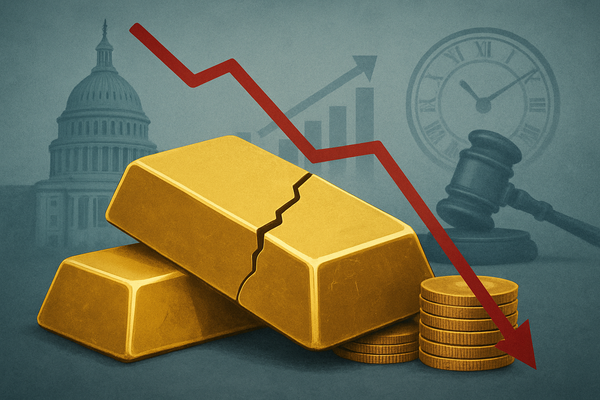Federal Reserve Signals "Near-Term" Rate Cuts: What It Means for Markets and the Economy

Federal Reserve Bank of New York President John Williams delivered a significant message to financial markets on November 21, 2025, indicating that the central bank has the capacity to implement "near-term" interest rate cuts without jeopardizing its crucial inflation target. These remarks, made at a Central Bank of Chile event, have immediately reshaped investor expectations, dramatically increasing the perceived likelihood of an imminent easing of monetary policy and sending ripples across global financial instruments.
Williams' commentary suggests a nuanced shift in the Fed's stance, acknowledging that while inflation progress has "temporarily stalled" at an estimated 2.75%, underlying pressures are expected to dissipate, allowing a return to the 2% target by 2027. Coupled with a softening labor market, these factors are paving the way for a potential policy adjustment aimed at moving the federal funds rate closer to a neutral stance, balancing the Fed's dual mandate of price stability and maximum employment.
Fed's Dovish Pivot: A Closer Look at Williams' Rationale and Market Impact
Federal Reserve Bank of New York President John Williams, a permanent voting member of the Federal Open Market Committee (FOMC), articulated a compelling case for "near-term" interest rate reductions on November 21, 2025. Speaking at an event hosted by the Central Bank of Chile, Williams characterized the current monetary policy as "modestly restrictive," asserting that there is "room for a further adjustment... to move the stance of policy closer to the range of neutral." This statement directly signaled a potential pivot in the Fed's strategy, moving away from its prolonged period of restrictive policy.
Williams' rationale for this dovish outlook is anchored in several key economic observations. Despite acknowledging that "progress on inflation has temporarily stalled," with current estimates placing it around 2.75%, he expressed confidence that broader price pressures would ease. He specifically pointed to the anticipated dissipation of tariff effects, which he estimates have contributed between 0.5 to 0.75 percentage points to the current inflation rate, projecting a return to the Fed's 2% target by 2027. Crucially, he noted that underlying inflation continues its downward trend without evidence of secondary effects from these tariffs. Furthermore, Williams highlighted a softening labor market, referencing a September unemployment rate of 4.4%. He drew a comparison to pre-pandemic levels, where a similar unemployment rate was not considered "overheated," suggesting that downside risks to employment have escalated while upside risks to inflation have diminished.
The timeline leading up to this moment has seen a complex interplay of economic data and policymaker commentary. Earlier in the year, many traders had scaled back expectations for further rate cuts, influenced by persistent inflation readings. However, the delayed September jobs report, which revealed a higher unemployment rate, provided fresh impetus for a reassessment. Williams' comments, coupled with the confirmation that no further significant labor market data would be released before the December FOMC decision, solidified market conviction.
Initial market reactions were swift and pronounced. Treasury markets saw yields fall sharply, with the two-year Treasury yield, a sensitive barometer of policy expectations, decreasing by as much as five basis points to 3.48%—its lowest level since late October. This reflected renewed investor confidence in the prospect of easing monetary policy. According to CME's FedWatch tool, the probability of a 25-basis-point rate cut at the upcoming December 9-10 FOMC meeting more than doubled, soaring to 75.1% from less than 40% the previous day. This significant repricing underscores the weight given to Williams' words, even amidst "strongly differing views" among policymakers, as revealed in the minutes from the latest FOMC meeting.
Corporate Fortunes: Who Wins and Who Loses from Easing Policy
Federal Reserve interest rate cuts, aimed at stimulating economic activity, create a significant ripple effect across various sectors and public companies. As the Fed leans towards further easing in late 2025 and into 2026, certain industries are poised to benefit, while others may face headwinds.
The primary mechanisms of impact include lower borrowing costs for businesses, which encourages investment and expansion, and increased consumer spending due to reduced debt payments. This environment generally favors companies sensitive to capital costs and consumer demand. For instance, the housing and construction sector is a clear winner. Elevated interest rates have previously stifled the housing market, but lower mortgage rates directly reduce homeownership costs, boosting demand. Homebuilders like PulteGroup (NYSE: PHM), D.R. Horton (NYSE: DHI), and Lennar (NYSE: LEN) are direct beneficiaries, alongside construction equipment manufacturers such as Caterpillar (NYSE: CAT) and material suppliers like Builders FirstSource (NYSE: BLDR).
Small-cap stocks, often more reliant on debt for growth and expansion, are also set to gain. Lower borrowing costs improve their profitability and make expansion more feasible, with the Russell 2000 small-cap index typically seeing a significant boost. Similarly, technology and growth stocks, particularly those in the artificial intelligence (AI) space, benefit as lower interest rates reduce the discount rate applied to their future earnings, increasing present valuations. Companies making substantial AI investments, such as Amazon (NASDAQ: AMZN), Microsoft (NASDAQ: MSFT), Meta Platforms (NASDAQ: META), Alphabet (NASDAQ: GOOGL), Oracle (NYSE: ORCL), Apple (NASDAQ: AAPL), and Tesla (NASDAQ: TSLA), will find cheaper financing for their large-scale initiatives.
Real Estate Investment Trusts (REITs) like Prologis (NYSE: PLD) and Realty Income (NYSE: O) also stand to benefit from lower borrowing costs for property acquisition and development, as well as increased demand for real estate in a healthier economy. Capital-intensive industries such as telecommunications and industrials, which often carry substantial debt, will see reduced interest expenses. AT&T (NYSE: T), with its significant debt load, could experience improved recurring revenue and free cash flow. Logistics companies like GXO Logistics (NYSE: GXO) are also poised to gain from increased economic activity driving demand for their services.
Conversely, banks and financial institutions face a more nuanced impact. While lower rates can stimulate loan demand, aggressive rate cuts can compress net interest margins (NIM), the difference between interest earned on loans and paid on deposits. If lending rates fall faster than deposit rates, profitability can suffer. However, some regional banks, such as First Horizon National Corporation (NYSE: FHN), might benefit from increased loan demand. Companies with large cash reserves or those heavily dependent on interest income will see their earnings decline as rates fall. Finally, savers and investors in short-term cash instruments will experience reduced returns on their deposits and money market funds.
Wider Significance: Reshaping the Economic Landscape
The Federal Reserve's recent interest rate cuts, initiated in September and October 2025, and the strong indication of further reductions, reflect a pivotal moment in the U.S. economy. These monetary policy adjustments are not isolated events but rather fit into broader industry trends, creating ripple effects across competitive landscapes, partnerships, and regulatory frameworks.
The current economic backdrop, characterized by slowing job gains, an uptick in the unemployment rate (though still relatively low), and persistent, albeit moderating, inflation, has necessitated the Fed's more accommodative stance. The cuts aim to stimulate economic activity by making borrowing cheaper for businesses and consumers, thereby encouraging investment, spending, and hiring. Sectors like technology and real estate are expected to respond positively, with growth stock valuations enhancing and property values receiving support. Manufacturing and consumer discretionary sectors could also see a boost from increased consumer purchasing power. However, the effectiveness of traditional monetary policy is being tested against structural economic changes, rapid technological advancements like the AI arms race, and altered global trade patterns.
The ripple effects on competitors and partners are significant. Lower borrowing costs will likely intensify competition as businesses find it cheaper to expand, invest in innovation, and even launch new ventures. This environment also typically fuels Mergers and Acquisitions (M&A) activity, with forecasts for 2025 and 2026 predicting a rebound driven by improved financing conditions and AI-related investments. Private equity firms, in particular, are expected to be active. A weaker U.S. dollar, a common outcome of rate cuts, could also benefit export-oriented companies and emerging market economies by reducing their dollar-denominated debt burdens. However, some research suggests that very low interest rates could, in the long run, stifle competition by favoring dominant firms over smaller competitors.
From a regulatory and policy perspective, the Fed's actions interact closely with fiscal policy. A record amount of tax refunds is expected in 2026, and the evolving geopolitical landscape, trade policies, and immigration decisions will all play a role. The combination of monetary easing and potential fiscal stimulus could reignite inflationary pressures. The Fed's dual mandate means a delicate balance must be struck between stimulating employment and managing inflation, a tension evident in the differing views within the FOMC. International economic relations are also impacted, as divergent interest rate policies between the U.S. and other central banks affect currency markets and cross-border capital flows.
Historically, Fed easing cycles offer mixed lessons. In 10 out of 12 rate cut cycles since 1965, the Fed began cutting only after equity markets had peaked, indicating a lag in policy responsiveness. While only two of 10 previous cycles avoided a recession, the current 2024-2025 cycle could mark a third "soft landing" if a recession is averted. The 1995 Greenspan-led rate cuts are often cited as a classic example of a U.S. soft landing. Investors have also historically underestimated the total scope of rate cuts the Fed would ultimately implement, especially during recessions. In the current context of November 2025, with several rate reductions already implemented, the ongoing debate within the FOMC underscores the complexity of balancing employment concerns with persistent inflation in a dynamic global economic landscape.
What Comes Next: Navigating the Path Ahead
Federal Reserve President John Williams' comments on "near-term" interest rate cuts, set against a backdrop of moderating inflation, a cooling labor market, and slower economic growth in late 2025, strongly suggest a leaning towards accommodative monetary policy. The path forward presents a complex landscape with distinct short-term and long-term possibilities for monetary policy, demanding strategic pivots from businesses and offering both market opportunities and challenges.
In the short-term (late 2025 / early 2026), an imminent rate cut in December remains a strong possibility, with market odds fluctuating based on incoming data and FOMC commentary. The Fed has already implemented two cuts in September and October 2025, bringing the benchmark rate to 3.75%-4%. However, an active debate continues among Fed officials, with some advocating for patience until inflation definitively approaches 2%, while others prioritize addressing signs of a weakening labor market. The Fed's decisions will remain heavily data-dependent, particularly on upcoming labor market reports.
Looking long-term (2026 and beyond), analysts like J.P. Morgan Global Research anticipate a continued easing cycle, with further cuts expected in 2026, potentially bringing the federal funds rate closer to 3%. The Federal Reserve Board's staff economic outlook projects inflation to return to its previous disinflationary trend after 2026, reaching the 2% target by the end of 2026. Monetary policy will strive for a "neutral" stance, balancing maximum employment and price stability. Economic growth is projected at 1.8% in 2026, with financial conditions becoming a tailwind as tariff impacts wane.
Businesses will need to execute strategic pivots and adaptations. Lower borrowing costs will provide financial relief and make investments in equipment, expansion, and new facilities more attractive, especially for small businesses. Increased consumer demand, fueled by lower debt payments, could boost sectors like retail, services, and hospitality. However, cheaper capital may also intensify competition and encourage new market entrants. Businesses should strategically re-evaluate capital expenditures, debt management, and growth plans to leverage the new rate environment, while remaining vigilant about global supply chain disruptions and geopolitical tensions.
Market opportunities are likely to emerge in equity markets, particularly the S&P 500, as monetary easing and liquidity injections support valuations. Historically, non-recessionary easing cycles have led to positive returns across most asset classes, with gold and U.S. high-yield bonds performing well. Lower bond yields are also anticipated, creating opportunities in fixed income. The environment is also ripe for mergers, acquisitions, and other deal activity, given the significant "dry powder" available for investment. Conversely, market challenges include the risk of persistent inflation, which could lead the Fed to pause or slow cuts, and increased market volatility due to the sharp divergence of views among Fed officials. Concerns about financial stability, particularly elevated leverage among hedge funds and life insurers, could also resurface if overly accommodative policies encourage excessive risk-taking.
The potential scenarios and outcomes include a baseline of a gradual rate decline and soft landing, where the Fed continues with gradual cuts into 2026, achieving a moderate economic slowdown without a severe recession, and most asset classes experience positive returns. An alternative is a hawkish pause/delayed cuts scenario, where the Fed maintains current rates longer due to persistent inflation, potentially stifling economic growth. Lastly, an aggressive cuts/recession scenario could unfold if the Fed responds to a sharper-than-expected economic downturn with drastic rate cuts, attempting to cushion a severe recession.
Comprehensive Wrap-Up: The Market Moving Forward
Federal Reserve President John Williams' recent comments, signaling "near-term" interest rate cuts, mark a significant moment for financial markets and the broader economy as of late 2025. The central bank appears to be carefully navigating a path to a more accommodative monetary policy, driven by a cooling labor market and a desire to return inflation to its 2% target by 2027, even as current inflation remains somewhat elevated.
The key takeaway is a heightened probability of further rate reductions, potentially as early as December 2025, with a broader easing cycle expected into 2026. This shift is poised to lower borrowing costs for businesses and consumers, stimulating investment, housing demand, and overall economic activity. Industries like housing, construction, small-cap companies, and technology firms are likely to be major beneficiaries, while banks and those dependent on high-interest income may face challenges.
Moving forward, the market will remain highly sensitive to economic data, particularly labor market reports and inflation figures. The internal debate within the FOMC regarding the pace and timing of cuts will also contribute to volatility. Investors should anticipate a period of opportunities in equities and certain fixed-income segments, fueled by cheaper capital and increased liquidity. However, vigilance is crucial, as risks stemming from persistent inflation, potential financial instability if policies become overly accommodative, and geopolitical uncertainties could still introduce headwinds.
In the coming months, investors should closely watch the outcomes of FOMC meetings, particularly the December decision, and monitor key economic indicators for signs of sustained disinflation and labor market stability. The most probable outcome is a gradual easing, aiming for a "soft landing" where inflation is controlled without triggering a significant economic downturn. However, the exact trajectory will depend on the Fed's ability to balance its dual mandate amidst a dynamic and evolving economic landscape.
This content is intended for informational purposes only and is not financial advice



